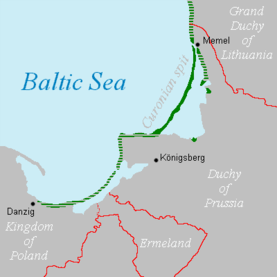Kursenieki language
| Kursenieki language | |
|---|---|
| Kursisk valuod | |
| Region | Curonian Spit (historically) |
Native speakers | 2 full, 3 partial, a few passive speakers[1] |
|
Indo-European
| |
| Language codes | |
| ISO 639-3 | – |
| Glottolog | None |
Kursenieki language[1] (Kursenieki: Kursisk valuod; Latvian: Kursenieku valoda) or Couronian language of Couronian isthmus[2] (German: Nehrungskurisch – 'Spit Curonian') is a dialect of the Latvian language spoken by the Kursenieki of the Curonian Spit, a thin strip of land stretching between southwestern Lithuania and Russia. In the process of various migrations of the 14th–17th centuries, Curonians (already speaking a Latvian dialect) settled along the Curonian Spit in East Prussia and became known as Kursenieki.

Kursenieki language was influenced by Old Prussian, Low German, High German and the Samogitian dialect successively, and by the end of the 18th century new Curonian dialects had formed, with the dialect of the Curonian Spit being notably distinct, due to its isolation from the mainland. Kursenieki vocabulary published in 1927 shows: 60% of Curonian words were the same as Latvian, 26% were loanwords from “German” (i.e. Low German and High German), and 13% from Lithuanian dialects. The Kursenieki language is mutually intelligible with Latvian, especially with its southwestern dialects, and Latvians can communicate easily with Kursenieki today.[3]
Before World War II, the Kursenieki language was a sociolect of Curonian fishermen of the Curonian Spit. In other spheres of everyday life Kursenieki used the Low German and High German languages. The events of the first half of the 20th century, including the Soviet and German occupations of the Baltic states and later East Prussia, led to the near extinction of the language, making it severely endangered. Several remaining native speakers live in Germany, having been expelled as "Germans" in the ethnic cleansing that took place in East Prussia after World War II.
References
- 1 2 Dalia Kiseliunaite: The sociolinguistic evaluation and recording of the dying Kursenieku language. Klaipėda University
- ↑ Skujiņa, Valentīna (2007). Valodniecības pamatterminu skaidrojošā vārdnīca. Riga: Latvian Language Agency. ISBN 978-99-849-8369-1.
- ↑ Pietsch, Richard: Deutsch-Kurisches Wörterbuch, Verlag Nordostdeutsches Kulturwerk Lüneburg 1991, p.17, ISBN 3-922296-60-2